Every week we get calls from customers asking us, “What are the major differences between your VertDesk v3 and the Uplift v2 desk?” This is a great question. Investing in a new electric standing desk is a large purchase and we understand the need for you to do extensive research before making a decision. The fact is, the VertDesk v3 might not be a good fit for everyone. Depending on your situation, the Uplift v2 could potentially be a better option for your needs. The goal of our comparison is to answer the tough questions in an open and honest manner, allowing you to select a product that is the best fit for you.
Full Disclaimer: We are an office furniture dealer and sell some of the adjustable computer desks we review. To learn more about the products we sell, our review process and why you can trust us, please visit: Why we’re different. Who is BTOD.com and The Breakroom Blog?
VertDesk v3 vs. Uplift v2 Links
– OEM Manufacturer
– Where Are Components Made?
– Pricing
– Assembly
– Specs / Features
– Stability
– Electronics
– Weight Capacity Testing
– Motors / Gears / Glides
– How They Operate
– Return Policy and Warranty
– Bottom Line
OEM Manufacturer
Uplift Desk is manufactured by Jiecang Linear Technology, based out of China and established in 2000 as a home care and medical furniture manufacturer. In 2011 they realized an opportunity for adding their linear actuator technology into frames to create electric standing desks. Today they are considered a leading Chinese manufacturer of standing desks.
The VertDesk v3 is currently manufactured by K&A Mfg. Inc., makers of RA Products and the standing desk brand, NewHeights. Based out of Schofield, WI, they were established in 1985 as an ergonomic accessory company. K&A Mfg. has evolved to include a full line of office furniture. They also provide OEM manufacturing for many large organizations and government agencies in the USA. K&A has been involved in the production of electric standing desks for over 15 years.
Where Are The Components Made
| VertDesk v3 | Uplift v2 | |
| Frame | Taiwan | China |
| Electronics | Hungary | China |
| Gears | Germany | China |
| Assembly | USA | China |
VertDesk v3 and Uplift v2 2024 Pricing
Current pricing and availability is a common question for customers. We found that laminate options from both brands are close in price, depending on the current offers available. The base-only option for the Uplift v2 is expandable and only has one price. The VertDesk v3 includes a fixed cross support and a fixed upper frame component. These additional items will increase the price of the frame as the size increases.
| Most Popular Sizes | VertDesk v3 | Uplift Desk v2 |
| Base (no top) | $735.99 | $469.00 |
| 30” x 60” Laminate | $859.99 | $699.00 |
| 30” x 60” Bamboo | n/a | $769.00 |
| 30” x 60” Solid Wood | $1,703.00 | $1,439.00 |
| Average Lead Time | 5 Business Days | 1-2 Business Days |
Assembly
Each desk requires about 30 to 90 minutes depending on your skill level. It is recommended to have a second person to help assemble and flip the desk over when completed.
The Uplift desk comes without the feet and work surface supports attached. The pain point for the Uplift base is attaching the feet; the allen wrench included in the box isn’t long enough for good leverage. We recommend using your own so that the feet are fully tightened. Also, consider adding Loctite Threadlocker for a more consistent hold on the foot assembly.
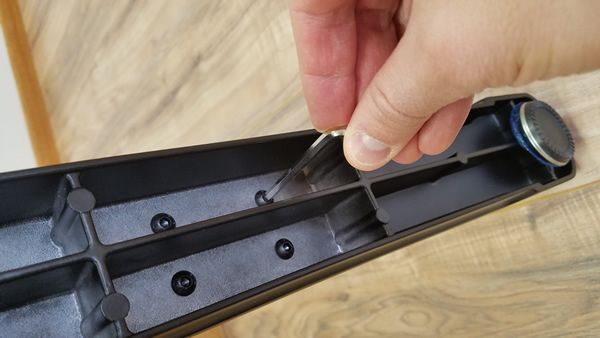
The VertDesk v3 has the feet and upper supports welded to the columns. The VertDesk v3 pain point is inserting the hex rod into the leg opposite the motor. If the gear inside the column isn’t perfectly aligned, you may need to use a wrench to turn the hex rod 1/12 to slide it into the column.
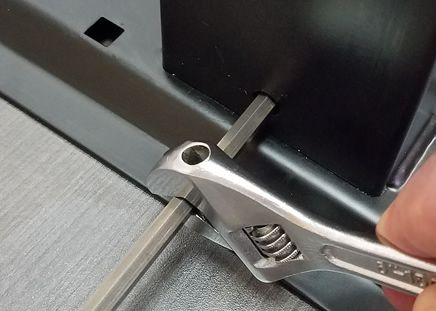
Standard Specs/Features Base Only
| Features | VertDesk v3 | Uplift v2 Desk |
| Button Options | Standard up/down push button | Standard up/down push button |
| Lifting Capacity | 275lbs | 355lbs |
| Motor(s) | Single | Dual |
| Adjustment Range | 27” to 47.5” | 24.5” to 50” |
| Adjustment Speed | 1.55” per second | 1.41” per second |
| Soft Start – Stop | Yes | Yes |
| Auto-dark LED display | Yes | Yes |
| Leveling Glides | .5” adjustment | .375” adjustment |
| Expandable Frame | n/a | 42.25” to 70” Wide |
| Anti-collision | Yes | Yes |
| Overload Protection | Yes | No |
| Frame Material | Steel | Steel |
| Foot Material | Steel | Molded Aluminum |
Stability of Each Desk
One of the most common questions with all standing desks is how stable they are. Do a search for any standing desk brand and you will see that Google recommended searches now include “brand + wobble”. There are two distinct motions that affect full standing desks; a front to back motion or the left to right wobble.
WobbleMeter Testing VertDesk v3 vs Uplift Desk v2
If you would like to see the pictures and videos of us testing the VertDesk and Uplift on the WobbleMeter, please visit the page for each brand (VertDesk v3 WobbleMeter and Uplift v2 WobbleMeter). Below is the deflection score range guide for the WobbleMeter. How these results impact your experience will depend on your sensitivity to wobble and rocking motions.
If you’d like to learn more about using the WobbleMeter visit: what is the WobbleMeter?.
WobbleMeter Score Range Guide

0-20 = Excellent Stability
Almost all of the desks tested at sitting height will score between 0-20. This is our baseline for excellent stability since most standing desks provide excellent stability at their lowest heights. Users in this range will not notice motion.
21-30 = Very Good to Good Stability
Between 20-30, most users will not notice the small amount of motion in this range.
31-40 = Good to Fair Stability
Between 31-40, some users may begin to notice the amount of motion in this range. This is especially true the closer the score is to 40.
41-50 = Fair to Bad Stability
Between 41-50, most users will notice the amount of motion in this range. This is especially true the closer the score is to 50.
51-60+ = Very Bad Stability
Between 51-60+ all users will notice the amount of motion in this range. This is especially true for scores that are above 60.
WobbleMeter Results for the VertDesk v3 Frame
Overall Wobble (Side to Side) Deflection Scores



Overall Rocking (Front to Back) Deflection Scores

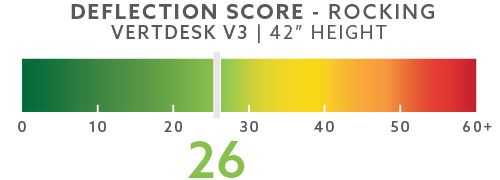
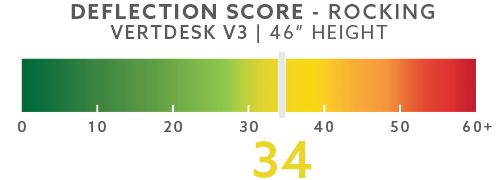
WobbleMeter Results for the Uplift v2 Desk Frame
Overall Wobble (Side to Side) Deflection Scores
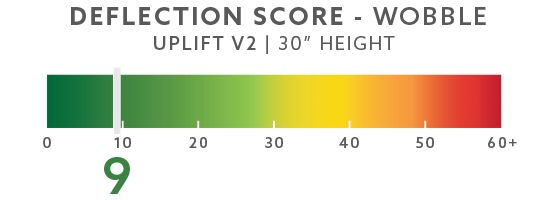


Overall Rocking (Front to Back) Deflection Scores

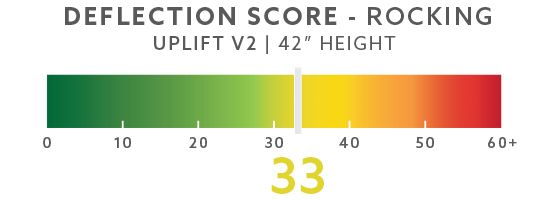

Note: Regardless of the electric standing desk selected, it is important to always fully tighten the hardware. Without proper assembly, all standing desks will have stability issues when extended.
Electronics Comparison
Both The VertDesk v3 and Uplift v2 offer smart electronic control box systems. Each brand offers a standard two button, up and down button. They also offer an optional four position memory function.
The VertDesk v3 features a single board control box system, engineered and manufactured by Laing Innotech, specifically for use in an electric standing desk. A four-layer circuit board is used to maximize functionality and create the smallest footprint possible. The components on the VertDesk’s circuit board are securely fastened with solid platforms and permanent soldered connections.
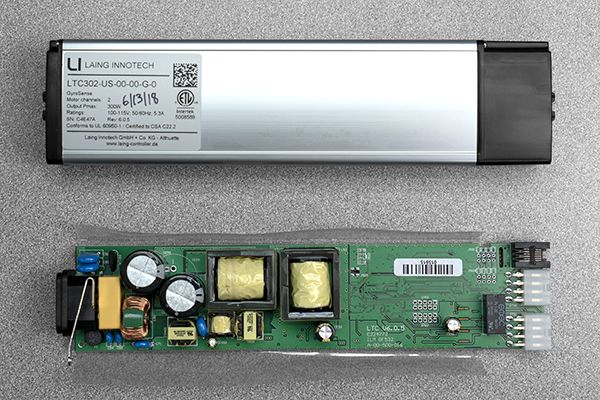
The VertDesk v3 includes one of the best collisions avoidance systems available. With the additional of GyroSense technology, the VertDesk v3 is able to detect soft collisions better than other software-driven systems. The system also allows you to adjust the sensitivity of collision avoidance, helping to reduce issues that can arise from false positives as the columns of the desk age.

The only true weakness we found with the VertDesk v3’s control box is the way the toroid core had been wrapped. Having previously used LogicData, this component was perfectly wrapped with no overlap. The current core has some overlap and this could be improved upon.
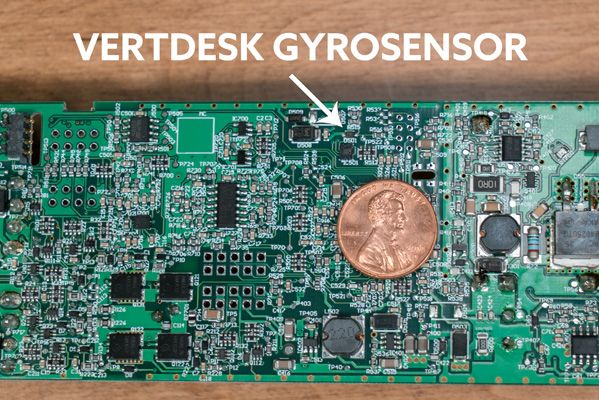
The Uplift v2 utilizes the two-board circuit board system we’ve found on many of the lower cost electric standing desks. This includes a mass-produced power supply system, which has significant amounts of silicone caulk to hold key components in place. The only Chinese made electric standing desk we’ve tested to utilize the higher quality single board system was on the VariDesk ProDesk 60 Electric. The Uplift v2 uses plastic clips to connect the two boards.
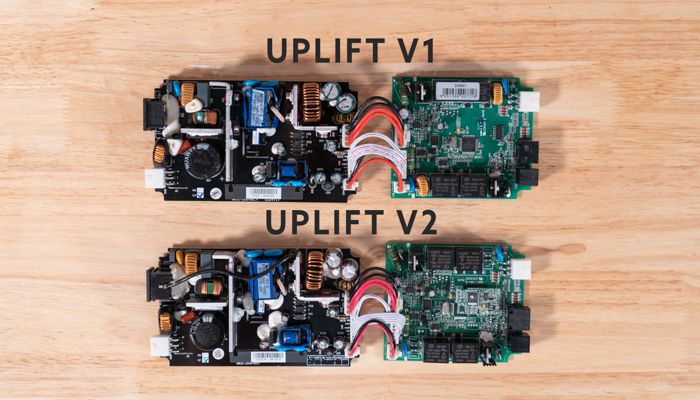
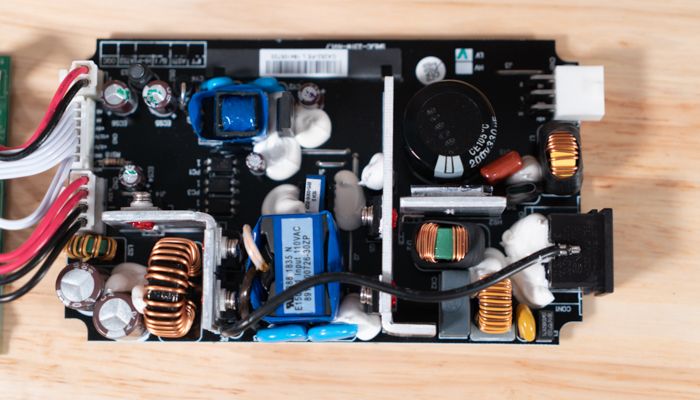
The Uplift v2 is only the second desk we’ve tested, besides the VertDesk, to include a collision avoidance system more advanced than the commonly used software drive option. With the use of accelerometers, they are able to offer one of the most sensitive collision avoidance systems we’ve tested. The use of this system gives the Uplift v2 an advantage over other JieCang frames not using similar technology.
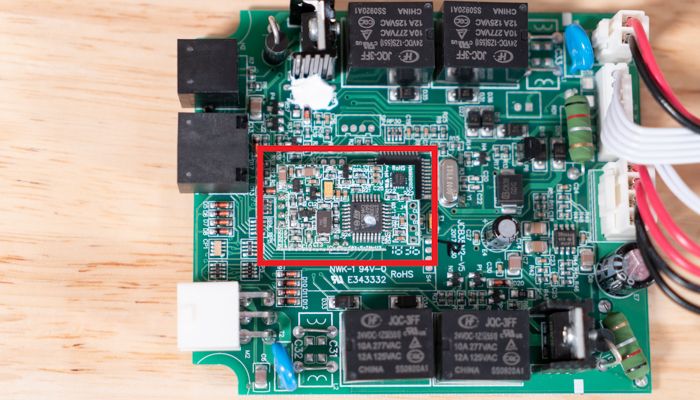
Weight Capacities and Testing
The Uplift Desks dual motor system boasts a large, 355 lbs. lifting capacity. We were able to test the frame with over 380 lbs. and the motors are strong enough to lift the load. We found the average speed for the frame is approximately 1.33”/second after ten cycles. When overloaded to 380 lbs., the speed only dropped down slightly to 1.26”/second.
Note: During our research, we found that the OEM manufacturer Jiecang shows a different capacity of 1000N (224.808 lbs) for this base. They list each leg has the ability to lift 800N. This leads us to believe that while the motors are strong enough to lift 360 lbs., they do not recommend it with the current configuration. This could potentially have to do with the lack of a traditional cross support.
The VertDesk v3 single motor system offers a more conservative 275 lbs. lifting capacity. We were able to turn off the control boxes overload protection to increase the capacity. We also loaded the desk with over 380 lbs. and found the motor was strong enough to lift the load. The average speed for the frame is approximately 1.55”/second after ten cycles. When overloaded to 380 lbs., the speed dropped to 1.27”/second.
Motor, Gear and Glide Comparisons
Over the past seven months, I have had the chance to review about eleven different electric standing desks. While I know that the information I provided was accurate, I really only scratched the surface on the first five or six desks. Since reviewing and comparing the IKEA Bekant to the VertDesk v3, I have started to pull all of the desks I review apart, looking at each desks internal components. Like a clock, the motors, gears and glides of each desk are what make them tick. To create a good experience, manufacturers have to pay close attention to the quality of these components. Below is an update on the Uplift Desk vs. the VertDesk v3 comparison, including these important details.
Motor Comparisons
The motors on the Uplift Desk and VertDesk v3 are similar in that they each use worm drives to turn a gear. This gear then turns the spindle gear that runs vertically through each column. Through testing we have found that both of these motors are powerful, having no issues lifting more than each desks max capacities.
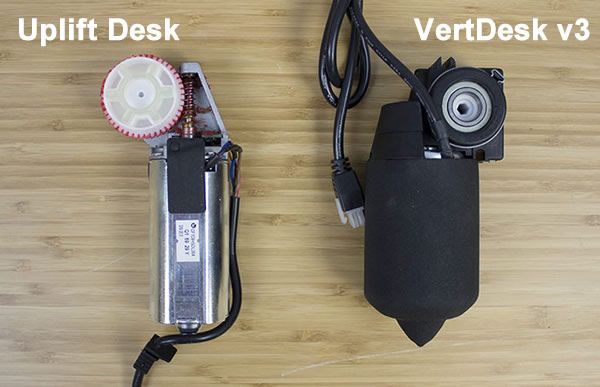
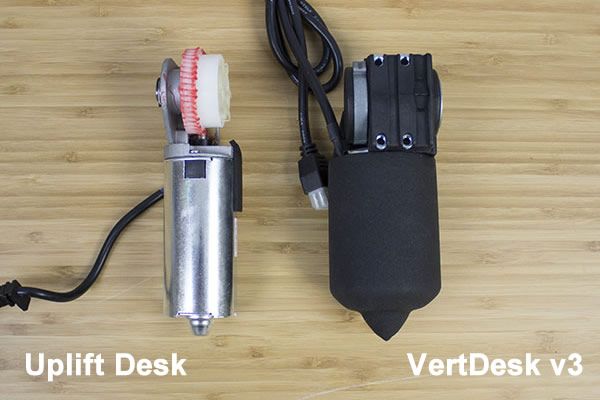
The Uplift Desk’s motor is currently manufactured, for JieCang, by a Chinese company called Shenzhen Weizhen Motor Co., LTD. According to Shenzhen’s website, they have been producing micro motor systems for close to 20 years. Overall, the motor appears to be well built, with a nice motor encasement. Unfortunately, like many of the other JieCang components, the worm drive and gear are over lubricated. So much so, that the lubricant has found its way on the microchip that is visible from the outside of the motor. I would have also liked to have seen the worm drive be internalized. Because this is exposed, there is an opportunity for contaminants such as dirt and dust to enter into the motor encasement.

The VertDesk v3’s motor is built by Ketterer, a leading German gear and motor manufacturer. Founded in the early 1800’s as a clock manufacturer (specialty gears), in the 1970’s they evolved creating a gear and motor division for vertical adjustment. The motor on the VertDesk v3 is well put together. All components, including the worm drive and gear system are fully sealed within a custom encasement. The gear system utilizes two bearings to improve efficiency.
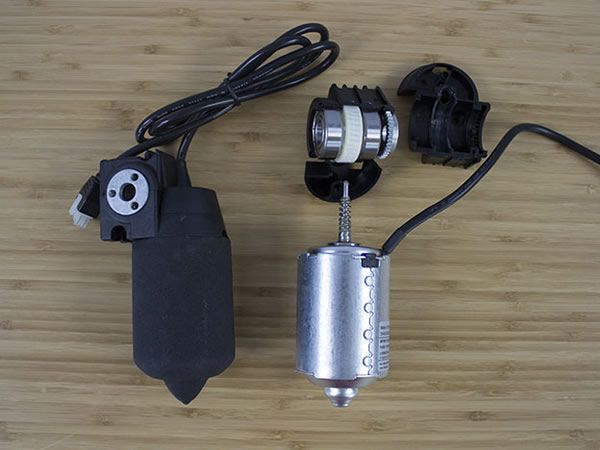
Gear Comparisons
The gear system on a standing desk is a key component to the smooth operation when making height adjustments. Low quality gears can create a host of issues, from decreased load capacities to complete failures that prevent the desk from making any adjustment at all. Proper manufacturing techniques, good quality control and utilizing the correct lubricants will ensure your standing desk gears hold up well over extended use.
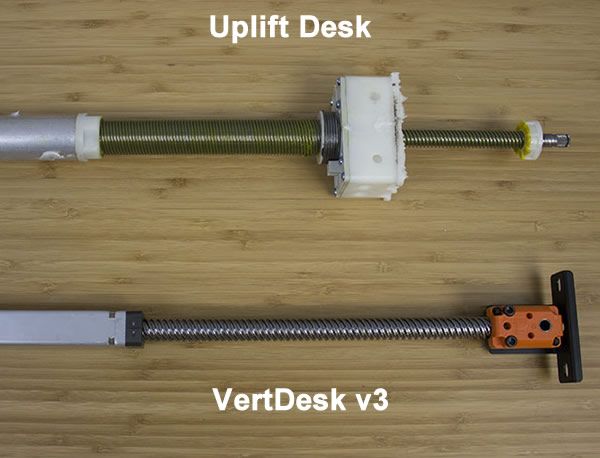
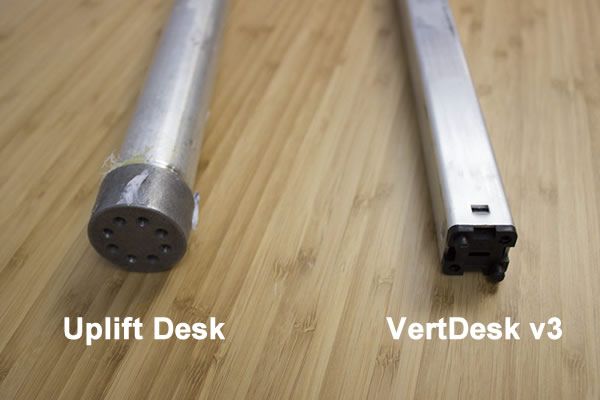
Having recently pulled apart a Jarvis Desk, I had expected to see the same gear system inside the Uplift Desk. Because the columns on the Uplift Desk are flipped, with small on bottom and big on top, the gear system was put together differently. Like the Jarvis Desk though, the Uplift Desk gears had similar over-lubrication issues. While this doesn’t necessarily mean that the gears won’t work well later in your ownership, over lubrication can reduce a gears efficiency over time. I’m also puzzled why there is so much grease. This could potentially be caused by a lack of quality control, with factory workers not being properly trained. The alternative reason could be that the gears require this amount of grease to continue functioning over the cycle testing that was performed.
The second thing that I noticed was the two different types of lubrication, a white grease used for the glides and a yellow grease for the gears. Because of their proximity to each other, they were easily able to cross contaminate. Through our own testing we have found that using the proper types of lubricants on gears and glides is extremely important. Using the right type of lubricants will ensure your desk moves smoothly for many years to come. Overall, the actual gear itself didn’t appear to be low quality, just over lubricated with a lot of moving parts.
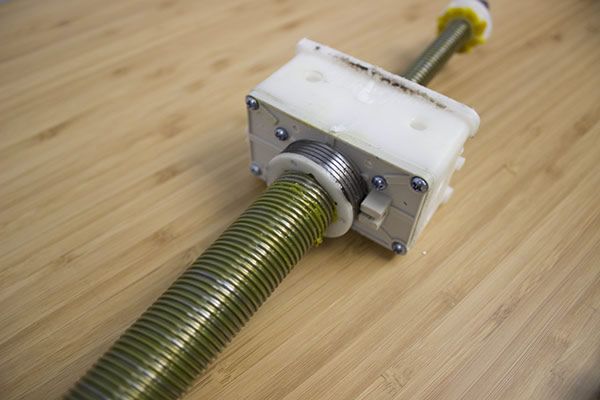
After cycle testing the VertDesk v3 21,375 times, we can attest to the fact that more grease or oil is not always better. The gear system on the VertDesk v3 is manufactured by Ketterer, the same German company producing our motor. It uses a minimal amount of oil on the rolled spindle gear, which is shown in the picture below. With exceptional engineering and a high quality control standard set by their organization, their gear systems work flawlessly. Over the course of the cycle testing, the gear itself remained almost exactly the same.
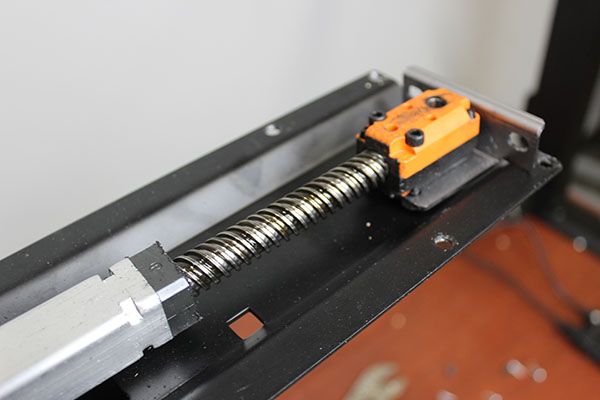
Glide Comparisons
Having the proper fit glides can make or break your standing desks stability and efficiency. Glides are used for two reasons: To provide the proper fit between the inner and outer column and to act as a lubricant. This allows the two pieces of metal to slide back and forth with ease. Having glides that do not properly fit, in production, will create stability issues. Utilizing glides that don’t hold up well over time will also create the same stability issues.
The Uplift Desk is the second JieCang column that I have opened, the first being a Jarvis Desk, a desk that I cycled about 400 times. The Uplift Desk has been cycled up and down only about 200 times, but did hold up better than the Jarvis Desk. Similar to the gears, the glide systems on the Uplift Desk had over lubrication issues. Based on the columns I opened on the Jarvis Desk, I had assumed this lubrication was required to make the glides function properly. While the Jarvis Desk has globs of grease, the Uplift Desk was spotty. Some portions of the glides had no lubrication on them at all and others had too much. This just raised more questions for me about the level of quality control that exists within the JieCang factory.
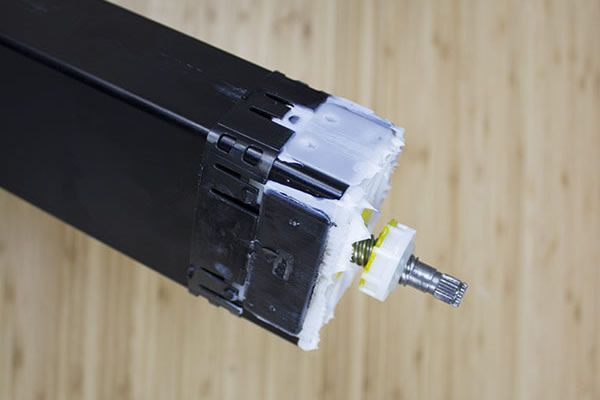
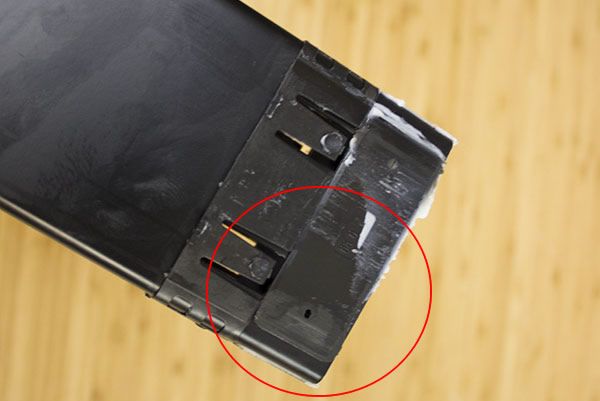
We have recently opened up a Linak DL5 column, the product that is used on the UpDesk elements series. Through this process, I learned how JieCang has developed their column technology. With most of the column being a knock-off from the premium Linak DL5, the Uplift Desk glide system fell short of the original. With cheaper plastics used for their glides and glides that didn’t create a perfect fit, the Uplift Desk columns had a noticeable play when you extended them half way and beyond.
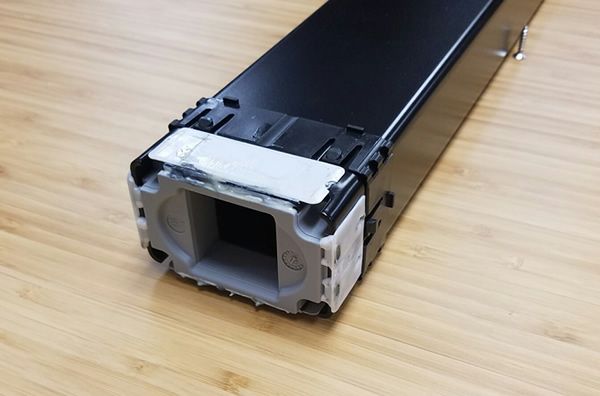
The glide system on the VertDesk v3 is made with highly durable acetal plastic from Dupont. This plastic is designed to provide good lubrication and hold up well to high count cycles. This high quality plastic requires little additional lubricant when sliding against the painted inner column, creating a much cleaner experience than the Uplift Desk. Because the lower glides slide against raw steel on the inside of the outer column, additional lubrication is added to create smooth transitions. This portion of the column is completely internalized and will never show on the outside of hte columns.

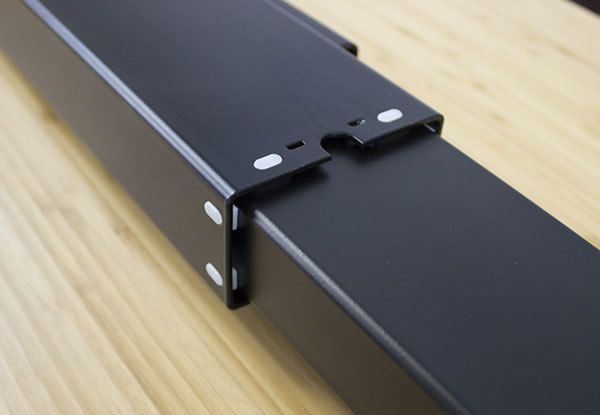
After our round of 21,375 cycles, we were able to test how the glides held up. The inner column glides that slide against raw steel saw the most wearing, with about .4mm lost over the test. The upper glides that slide against the painted column only lost about .09mm. This minimal amount of wearing allowed the VertDesk v3 to still remain stable after a lifetime of cycles. It did, however, have more movement than when it was brand new.
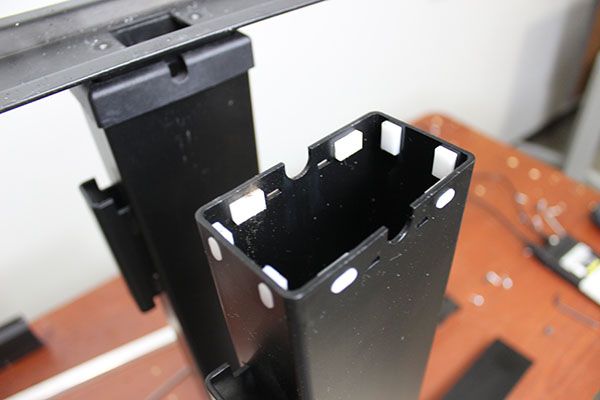
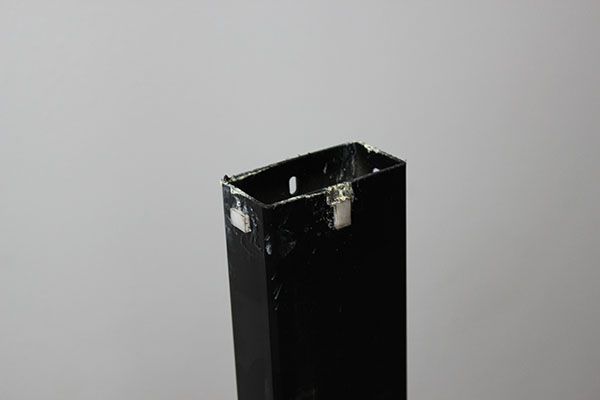

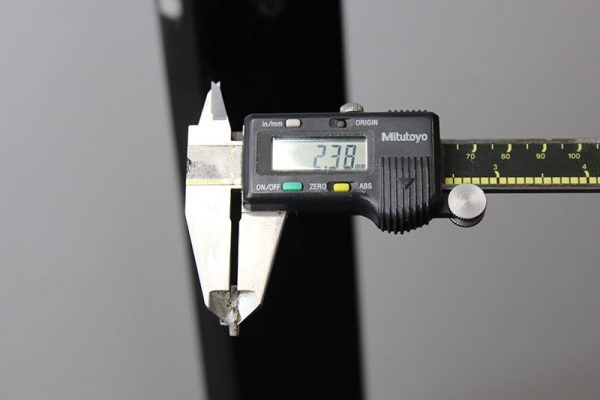
Weight Capacity Testing
Frame Colors
| VertDesk v3 | Uplift v2 |
| Black, Silver and White | Black, Silver, White and Metallic Industrial Style |
Desk Top Options
If you decide to get the entire desk with top, the VertDesk v3 and Uplift are available in an assortment of top options.
The VertDesk v3 currently has a larger selection of Greenguard laminate tops with eleven wood grain prints and solid color options available. There are 304 size options, with the ability to select any size from 23″ to 30″ deep and 36″ to 72″ wide, in full inch increments.
The Uplift Desk has a better selection of bamboo, hardwood, and reclaimed wood top options. It comes nine different size options, with two overall depths of 24″ and 30″. It is available in 42″, 48″, 60″, 72″ and 80″ wide.
Optional Upgrades
| VertDesk v3 | Uplift v2 | |
| Programmable Button | $73 | $29 |
| Power Option | $39/each | $39 single / $69 pair |
| Locking Casters | $55/set | $29/set |
| Wire Management Kit | $36-$189 with power strip | Up to $29-$89 with power strip |
Return Policy
| 30 Days + Free Returns | 30 Days + Free Returns |
Warranty
| Lifetime warranty on everything. | 15 year warranty for the frame. This includes the motors, control box, and switch. The desktops are covered for a period of 5 years. |
Bottom Line
After extensive testing with each product, they are some of the best options from within the mid-range category. The Uplift v2 offers a wider adjustment range, higher weight capacity and boasts a seven-year warranty. The VertDesk v3 is a more stable option at all heights, utilizes a high-end electronic/gear system and is currently assembled in the USA for better quality control. Both desks are similar in price, with only about 5-10% difference between the various versions. Depending on your specific needs I can see both options being a good fit.
More Standing Desk Resources
- The 4 Best Electric Standing Desks Under $800
- How long will your VertDesk v3 last? We tested to find out.
- VertDesk v3 vs. NewHeights XT: Which is better?
- A Standing Desk Evolution: VertDesk v1 and v2 VS. VertDesk v3
- VertDesk v3 Accessories Explained
- How Much Does an Electric Standing Desk Cost?
- 9 Most Common Problems With Motorized Standing Desks







